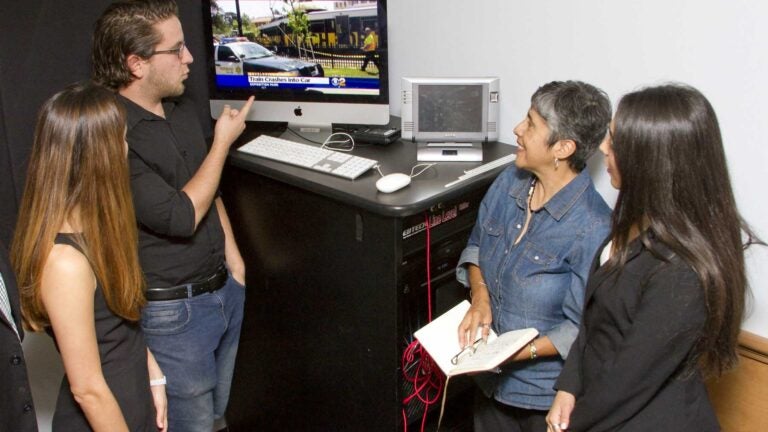
Film producer Patricia Ovando, right, receives legal advice from USC Gould law students. (Photo/Gregory Mancuso)
Aspiring attorneys advise filmmakers on tricky tech issues
A new partnership at USC finds law students helping documentarians who seek intellectual property know-how
During the fall semester, USC third-year law student Paul Bruene worked with the filmmakers of Into the Trenches, a documentary about a war veteran who struggles with PTSD. Bruene was one of the students in the Intellectual Property and Technology Law Clinic at the USC Gould School of Law to receive that opportunity.
The collaboration was possible thanks to a first-time partnership with the USC School of Cinematic Arts. In this mutually beneficial experience, law students get hands-on legal experience while the filmmakers learn about copyright law and the fair use doctrine, knowledge that could serve them in the future.
“Documentary filmmakers often self-censor when they don’t have access to legal expertise,” said Professor Valerie Barreiro, director of the clinic. “They may decide not to use archival footage, music or any other material that they themselves haven’t shot for fear of facing a lawsuit or a high licensing fee.”
Recognizing that USC has many high-caliber filmmakers on campus, Barreiro approached the cinematic arts school and offered the clinic’s help. She eventually connected with Professor Lisa Leeman, who teaches an intermediate production course.
A documentary filmmaker herself, Leeman knew the advantage of having Barreiro and her students share their legal expertise.
“I’ve had to evaluate fair use factors and, in terms of teaching the concept, what’s challenging is that while courts have spelled out general criteria, they have deliberately left this area open to interpretation. Meeting the criteria is all about context. You have to individually analyze and interpret each piece of copyrighted material you want to use.”
Taking no chances
Bruene describes himself as “heavily focused on intellectual property.” The collaboration with documentary students, he said, “incorporated what I’ve learned from a number of classes.”
He sees the role of the clinic’s students as “mostly risk mitigation. We help move something from ‘maybe OK’ to ‘probably OK’ or even better ‘almost certainly OK.’ ”
For Into the Trenches, the filmmakers wanted to include some third-party footage, brief clips of a local news report and a few pictures that the editors had found on the internet.
Patricia Ovando, one of the film’s producers, credits the clinic’s students with helping her team troubleshoot delicate situations by suggesting simple fixes, such as adding context via a voice-over, as well as complicated legal issues regarding fair use specifically with regard to video clips from news or movies.
She said that she will apply the lessons she has learned to future films she plans to produce.
“For the rest of my career, every time I make a documentary; if I download a photograph or a clip, I will be asking myself: ‘Is this a fair use and why?’” she said.
From law school to legal eagle
The collaboration is gratifying news to Chris Perez ’09, whose student involvement with the clinic led to employment at Donaldson + Callif LLP, where he is a partner representing independent filmmakers.
“It’s not only a better learning experience to get the schools working together, it also gives alumni like me a reason to come back to teach and impart any kind of wisdom that we have,” he said.
An avid fan of documentary films, Barreiro said the collaboration is a chance to play a dual role. First, to provide her students with a tangible opportunity to apply the law in a context of a real, expressive work, while sticking to a deadline. And second, to provide resources and tools to the emerging filmmakers.
“When they graduate and produce their films, they’ll be able to make informed choices and reduce their fear of litigation,” Barreiro said. “Ultimately, we want to ensure that we get to see their stories.”
